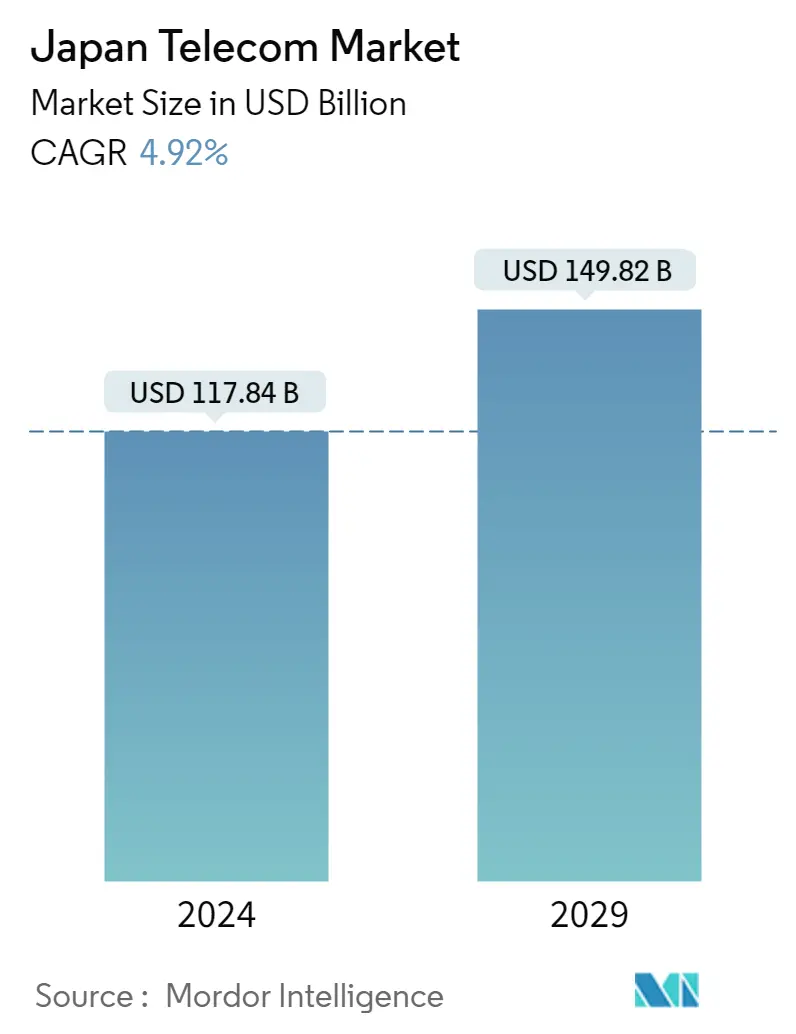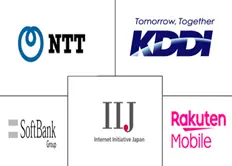Market Size of Japan Telecom Industry

| Study Period | 2019 - 2029 |
| Base Year For Estimation | 2023 |
| Market Size (2024) | USD 117.84 Billion |
| Market Size (2029) | USD 149.82 Billion |
| CAGR (2024 - 2029) | 4.92 % |
| Market Concentration | Low |
Major Players
*Disclaimer: Major Players sorted in no particular order |
Japan Telecom Market Analysis
The Japan Telecom Market size is estimated at USD 117.84 billion in 2024, and is expected to reach USD 149.82 billion by 2029, growing at a CAGR of 4.92% during the forecast period (2024-2029).
Japan has a highly developed infrastructure that allows its people to be constantly connected. Along with having a high internet penetration rate, Japan has a sizable mobile internet user base, which reflects the rising popularity of smartphones. Though the smartphone adoption rate is strong, more individuals are anticipated to utilize smartphones in the years to come.
- In Japan, the Telecommunications Business Law was changed in October 2019 to encourage competition in the mobile sector and safeguard users. Since then, there have been conversations about reducing mobile phone fees to lessen the load on users. The Ministry of Internal Affairs and Communications unveiled an action plan to lower mobile phone costs by creating a fair and competitive mobile market. By March 2021, all MNO companies introduced new, less-priced brands and pricing schemes, some of which included 20 GB of data.
- It might take a decade for 6G telecommunications to reach its full potential, but Japan is already establishing its own domestic network and technology foundation. The Japanese government plans to invest billions of dollars in promoting the development of ultra-high-speed communication. Japanese equipment manufacturers NEC and Fujitsu, as well as Finnish equipment manufacturer Nokia, announced plans to conduct experimental trials of new mobile communications technologies for the targeted commercial launch of 6G services by 2030.
- Though system and protocol evolution continued due to the Internet, the development of mobile networks was constrained by closed cultures and proprietary technologies for a very long time. Mobile networks must be able to offer modification and dynamic set up on the spot to be essential infrastructure for many different sectors. By integrating RESTful (Representational State Transfer) application programming interfaces (APIs), SoftBank tailors and modifies its network to meet the needs of consumers and offer more convenient services.
- The COVID-19 outbreak significantly impacted the Japanese economy. The adoption of digital technology was essential for the nation to become more resilient during and after the pandemic. Technology applications can help businesses and their employees manage the financial effects of COVID-19 by assisting them in contacting clients and conducting business digitally, restarting business operations, and implementing technologies that reduce logistical bottlenecks. A sizable 69% of Japan's digital opportunity, valued at JPY 46.8 trillion (USD 434 billion), was thought to be sourced from technology that assists companies and employees in managing the effects of the pandemic on the economy.
Japan Telecom Industry Segmentation
The study provides an in-depth analysis of the telecommunication industry in Japan. Japan's telecom market is segmented by services, which is further classified into voice services (wired, wireless), data and messaging services, and OTT and pay TV.
| Segmentation by Services (Coverage to include Average Revenue Per User for the overall Services segment, Market size and Estimates for each segment for the period of 2020-2027 and in-depth Trend Analysis) | ||||
| ||||
| Data and Messaging Services (Coverage to include Internet & Handset Data packages, Package Discounts) | ||||
| OTT and Pay-tv Services |
Japan Telecom Market Size Summary
The Japanese telecom market is characterized by its advanced infrastructure and high internet penetration, which supports a substantial mobile internet user base and the widespread adoption of smartphones. The market is highly competitive, with major players like Nippon Telegraph and Telephone Corporation, KDDI Corporation, SoftBank Group Corp., and Rakuten Mobile, Inc. leading the charge. Regulatory changes, such as the Telecommunications Business Law amendment in 2019, have fostered competition and encouraged cost reductions in mobile services. The government's proactive stance in promoting digital transformation and ultra-high-speed communication technologies, including significant investments in 6G development, underscores Japan's commitment to maintaining its leadership in the global telecom landscape. The COVID-19 pandemic has further accelerated the adoption of digital technologies, enhancing resilience and driving innovation across various sectors.
The market is also witnessing a shift towards 5G and beyond, with significant investments in infrastructure and technology trials by key players. The deployment of 5G base stations and the introduction of new pricing schemes have made 5G more accessible, with expectations of it becoming the primary cellular technology in the coming years. Companies like SoftBank and NTT Docomo are at the forefront of this transition, with initiatives like Multi-access Edge Computing (MEC) and 5G Standalone networks enhancing service quality and security. The integration of RESTful APIs and open innovation practices are further enabling telecom companies to tailor their services and foster collaboration with regional authorities and businesses. This dynamic environment is poised to drive growth and innovation, positioning Japan as a pivotal player in the future of telecommunications.
Japan Telecom Market Size - Table of Contents
-
1. MARKET INSIGHTS
-
1.1 Market Overview
-
1.2 Industry Ecosystem Analysis
-
1.3 Industry Attractiveness-Porter's Five Force Analysis
-
1.3.1 Bargaining Power of Suppliers
-
1.3.2 Bargaining Power of Consumers
-
1.3.3 Threat of New Entrants
-
1.3.4 Threat of Substitute Products
-
1.3.5 Intensity of Competitive Rivalry
-
-
1.4 Impact of COVID-19 on the Industry Ecosystem
-
1.5 Regulatory Landscape in the Country
-
-
2. MARKET SEGMENTATION
-
2.1 Segmentation by Services (Coverage to include Average Revenue Per User for the overall Services segment, Market size and Estimates for each segment for the period of 2020-2027 and in-depth Trend Analysis)
-
2.1.1 Voice Services
-
2.1.1.1 Wired
-
2.1.1.2 Wireless
-
-
2.1.2 Data and Messaging Services (Coverage to include Internet & Handset Data packages, Package Discounts)
-
2.1.3 OTT and Pay-tv Services
-
-
Japan Telecom Market Size FAQs
How big is the Japan Telecom Market?
The Japan Telecom Market size is expected to reach USD 117.84 billion in 2024 and grow at a CAGR of 4.92% to reach USD 149.82 billion by 2029.
What is the current Japan Telecom Market size?
In 2024, the Japan Telecom Market size is expected to reach USD 117.84 billion.

